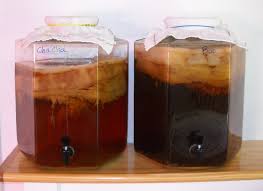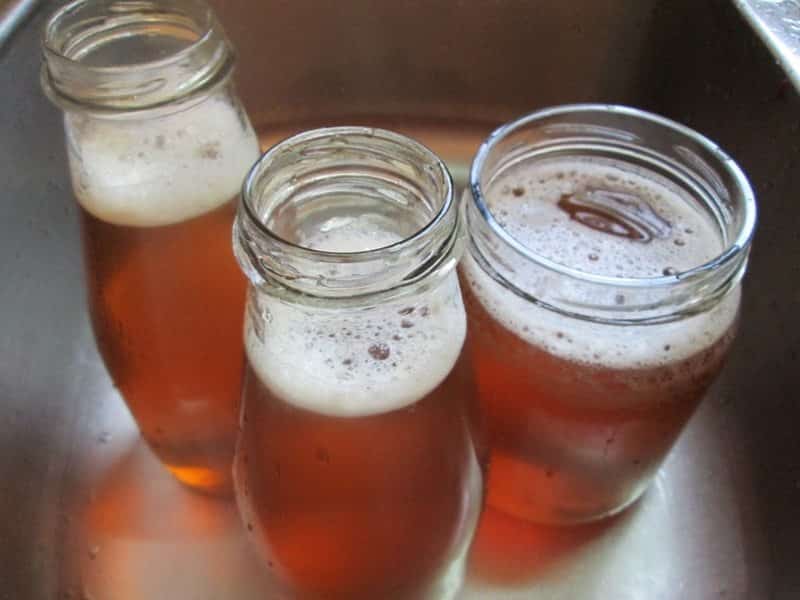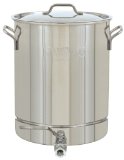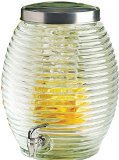Creating a Kombucha Continuous Brew System

For a never-ending supply of fresh kombucha tea, you can create a kombucha brewing system where you have two or more SCOBYs working at once in batches that you’ve started at different times. Since it takes between 7 and 30 days to fully ferment the sweetened tea into probiotic kombucha tea, you could even start a new brewing container and SCOBY each week, so that at the end of the week you’ll be sure to have a new supply of fermented tea.
Or … you could set up a continuous brew system, and get the same results.
What is a Continuous Brew System?
Doing a continuous brew is exactly like regular kombucha brewing, with one main difference: the SCOBY stays in the brewing container.
In single-batch brewing, you fill a brewing container with sweetened tea and starter liquid and add the SCOBY, and then let the microorganisms completely ferment most of the sugars in the mixture while producing the organic acids that make kombucha full of healthy nutrients. When the fermented tea has the right pH and sweet-sour flavor, you remove the SCOBY, pour out the liquid, clean the container, and fill it up again with a new supply of sweet tea mixture, starter liquid, and SCOBY. You’ll do this for each batch of kombucha tea.
When you have a continuous brew system set up, you’ll start the process in the same way, but only for the first batch. Instead of removing the SCOBY and all of the fermented tea, you’ll leave the SCOBY in the container and only remove as much fermented tea as you want to drink right now. Then you’ll pour in the same amount of fresh sweetened black (or green) tea to replace what you removed and to give the SCOBY more food to work with. As long as you’re doing this regularly, and as long as you don’t remove too much fermented tea at once, you’ll have a steady supply of well-balanced fermented kombucha tea to drink. You’ll only have to remove the SCOBY and clean the container every few months, instead of every few weeks.
Which is Better?
Whether you stick with single-batch brewing, set up a continuous brew system, or use a combination depends on how much kombucha you drink, whether you like plain or flavored kombucha, how much space you have in your kitchen (or wherever you’re doing your brewing), and how much space you have to store bottled kombucha, if you like to add flavor to kombucha during second fermentation. When you’re just starting out, you might find it easier to do single-batch brews, especially if you aren’t making very much kombucha at first. As you get more experience with brewing – and more addicted to drinking kombucha! – you can look into the pros and cons of continuous brewing and see which method you prefer.
Continuous Brewing Equipment (What You Need)

You can set up a continuous brew system using the same jars for brewing kombucha that you normally use, but only if you have a way to remove the fermented tea without disturbing the SCOBY. Some people use a plastic or stainless steel ladle to gently push the SCOBY down into the liquid and fill up the ladle to remove the liquid, but doing this too often can harm the SCOBY and interfere with the development of the “baby” SCOBY (the Symbiotic Colony Of Bacteria and Yeast) that forms on the surface of the fermenting tea.
The Better Way
A better idea is to use a container that has a spigot towards the bottom. This will let you draw off the fermented tea any time you want a fresh glass, without touching the SCOBY at the top of the jar. You can find this type of container in a variety of sizes, made out of different materials. Choose the one that suits your price range, one that will hold at least the amount of kombucha you want each week, and one that fits the space you have available in your kitchen or on top of a counter.
Container Size
Unlike single-brew kombucha, you’re going to need to leave enough fermented tea in the container each time you siphon some off to maintain the acid balance in the mixture after you add the new sweetened tea. If you’re using a half-gallon jar, but there are four people in your family and you each drink two cups of kombucha tea every day, you’ll drain the container. There won’t be any fermented tea to use as a starter, and it will take the SCOBY at least a week to get a new batch of starter and sweet tea back to the right pH.
If you drink a lot of fresh tea, or draw off more tea to flavor and bottle on a regular basis, you’ll want to get a container that holds one gallon of liquid or more.
Most people choose a container that holds at least one gallon. However, we recommend you choose a container that can hold at least two to five gallons of Kombucha to see the benefits of continuous brewing — both in taste and time savings. If you are only brewing 1 gallon containers, you are probably better off just doing regular non-continuous brews.
Container Material
You can use a container that is made of any food-safe material that will not react with acid. The material of the container itself and the spigot mechanism need to be made out of glass, stainless steel, food-grade plastic, ceramic, and/or wood.
Wood Barrels
Wood barrels have been used for aging and fermenting foods and drinks for thousands of years. You can get the same “vintage” effect that winemakers and whiskey makers rely on to develop complex flavors in their brews using wood, because the kombucha microorganisms and flavor components will infuse the wood and add to the fermentation of each new batch.
You can source your own oak barrel if you wish — expect to pay some good coin. However, we feel oak may give the best tasting Kombucha, especially if you experiment.
20 Liter Oak Barrel (5 Gallons)
We recommend this 20 liter oak barrel for Kombucha which includes a stand and a spigot.
5 liter Oak Barrel
This is a much smaller sized wood barrel. 5 Liters is pretty small, but if you want to play around with continuous brewing without committing too much, then this is a good intro.
Stainless Steel Containers
Stainless steel is used in commercial beer brewing and wine brewing systems, and it works well for kombucha, too. You should be able to find a container in a range of sizes, especially if you go to a brewing supply company.
16 Gallon Stainless Steel with Spigot
This is a 16 gallon stainless steel container. Good for a real continuous brewing system if you want a substantial amount. Note, this will give you enough to produce a serious amount of Kombucha all the time — so keep this in mind. Only for large families of serious drinkers, multiple households, or commercial.
8 Gallon Stainless Steel Container
This 8 gallon stainless steel container is big enough to keep a household in continuous Kombucha production.
Ceramic Containers
Ceramic (porcelain) containers are popular because they help keep the kombucha at a steady temperature. Ceramic resists changes in temperature, and will not heat up as quickly as stainless steel, glass, or plastic if the air temperature rises. If you struggle with keeping kombucha cool in hot weather then this type of continuous brewing container is a good choice. The danger of ceramic is that if the glaze is scratched on the inside, where the surface touches the Kombucha, toxins may leak into the Kombucha. However, this type of container is popular with some brewers.
5 Gallon Porcelain Container
This container works well with Kombucha, having both a spigot and wooden stand. There are different sizes offered, but I recommend the 5 gallon size.
Glass containers
These are easy to find, because “sun tea” has been popular since the 1970s. In fact, you might even be able to find used sun tea jars at yard sales or thrift shops. This type of container is cheaper than most of the other options. Make sure that the spigot is made out of porcelain or stainless steel if possible. A plastic spigot may not be made of acid-resistant food-grade plastic, and will sometimes have a rubber seal. The acids in the kombucha will wear away the rubber over time. If you decide to use glass, make sure that you have a place to store it that’s out of direct sunlight and does not get too much artificial light. You can wrap a towel or other cloth around the container to help block the light.
3.5 Glass Jar with Spigot
For continuous brewing, we recommend anything as long as it’s big enough (2+ gallons and has a stainless steel spigot).
This 3.5 gallon jar with a spigot works great for Kombucha. I recommend it because it’s big (for a glass jar) at 3.5 gallons which is enough for a nice, easy to control continuous brew.
Plastic Containers
Food-grade plastic can be used for continuous brewing as long as it resists acids. You can find large plastic containers with spigots at stores that supply restaurants and caterers, or at brewing supply stores. The disadvantage with these is the size of the opening on the top – the bigger the container, the wider the diameter of the opening. You may have a hard time keeping a tight seal on the material you use to cover the top of the brewing container.
How to Continuous Brew
Here’s how to start, assuming you have the equipment at hand.
Step 1: Have a large container suitable for Continuous Brewing
Make sure you have a proper container for continuous brewing. We highly recommend either a stainless steel with spigot, large glass jar with spigot, or oak wood barrel container with a spigot for your container. Use 2 gallon to 5 gallon sized containers. If you want to start small, you can try a 1 gallon container, but we feel this is really too small to give you the benefits that a continuous brew will bring to the table in taste, time savings, and ease.
Step 2: Preparation and Location
Be sure to clean your container before you use it for the first time. Do not use antibacterial soap, just very hot water and a mild soap that rinses clean. If you want to use a wood barrel, check the cleaning instructions first. Do a final rinse with distilled white vinegar to wash away any soap residue.
Choose a location for the container where you won’t have to move the container to siphon off the fermented tea, add new sweetened tea to the container, or get the container out of the way of your normal everyday activities. The container should be out of direct sunlight.
Step 3: Filling the Container (The Initial Batch)
Use the same kombucha brewing ratios that you have been using to make a single batch of kombucha tea. For a one-gallon container, you’ll need:
- 14 cups of boiled filtered water
- 8 bags of tea (or 8 teaspoons of loose tea leaves)
- 1 cup of sugar
- 2 cups of starter liquid
Once you have mixed the cooled sweet tea with the starter liquid, pour a little bit into the clean container, then add the SCOBY. Depending on the size and shape of the container, you might not want to add all of the rest of the liquid, to give the SCOBY enough room to float at the top of the container. If you have extra liquid, add it to your SCOBY hotel.
Let the kombucha tea ferment as usual. As an estimate the brewing time of kombucha will be around 10-14 days before the pH of the fermented tea is between 2.5 and 3.2 but it can be as short as 7 days if the temperature is elevated and/or the SCOBY is very active, or stretch to three or four weeks. Keep testing the tea daily until it has the flavor and acidity you want.
Step 4: Filling the Container (The Continuous Batch)
Once the fermented tea is ready to drink, you can use the spigot to remove as much as you want – up to a certain point.
In general, you should be able to remove between 20% and 30% of the fermented tea every day. Pour in the same amount of sweetened tea into the top of the container (you can pour it right on top of the SCOBY). It will take a day or two for the SCOBY to process the new food at the top of the container, while you’re removing the brewed tea from the bottom of the container.
NOTE: Be sure that your sweetened tea has cooled to room temperature before you add it to the continuous brewing container, or you may shock or harm the SCOBY.
If you remove more than about 25% of the fermented tea, it will take the SCOBY longer to process the new sweetened tea to the right acidity. That means when you drain off more tea the next morning, it might be sweeter than you like. Be sure to give the SCOBY enough time to work on its new food.
It is a good idea to leave at least 50% of the fermented tea in the container so that the pH of the brew stays as balanced as possible. If you remove more than that, you’re starting over, just as you would with a single-batch brew, and you’ll have to wait at least a week for the fresh fermented tea to be ready.
Continuous Brewing Tips
Here are some tips that will help you produce better batches of continuous brews. Please note that it may take a few batches and some experimentation on your part before you start to perfect your brewing. If your first few brews don’t taste as good as you might expect, don’t give up — you’ll need to tinker around with some of the brewing variables.
Tea and Sugar For Continuous Brewing
Because you’re adding new sweet tea to the older fermented tea in the container, the flavor of the liquid that’s currently in the jar can be changed by the flavors in the sweet tea that you’re adding. For example, you might start out by using black tea, but then begin using a mix of green and black tea, ending up with green tea alone. You can also use different types of sugar for kombucha to change the flavor.
However, if you use anything other than leaves of the Camellia sinensis plant to brew your sweet tea, or a sugar that’s harder to break down than raw organic white cane sugar, your SCOBY will not process the ingredients in the same way. The brewing time may change, and long-term use of ingredients like herbal tisanes and agave syrup (neither of which provide the complete nutrient profile a SCOBY needs) will harm your SCOBY. If you’re going to experiment with different ingredients, you’ll probably be better off doing that in a separate single-batch container, and using your continuous brewing system for regular plain kombucha tea.
NOTE: It’s not a good idea to add any of the flavoring ingredients for kombucha in the continuous brewing container because you won’t be able to get them out again easily. You’ll also run the risk of clogging up the spigot, contaminating the SCOBY, and allowing opportunities for mold to develop.
Cleaning the Container
If you’re using a glass container, you’ll be able to easily see whether or not there’s a lot of yeast particles and dead material collecting at the bottom of the container, which will help you decide when it’s time to clean the container. No matter what type of container you’re using, if you find that your fresh tea is “yeasty” or “malty” then there is too much yeast and dead material building up, and it’s a good idea to clean the container immediately. These extra particles will also potentially block your spigot.
In general, you should clean your container every 3 to 4 months, if not more often. This will help keep the liquid in the container at a good balance, help keep dead material from building up on the bottom and sides of the container, and give you an opportunity to check on the health of the SCOBY.
Wash and rinse your hands and pull out the SCOBY. Put it in a clean glass bowl, pour two cups of the tea from the container over the SCOBY, and cover the bowl with the cloth you’ve been using to cover the brewing container. Save the rest of the tea to drink during the next 7-10 days.
Scrub out the container with hot water. Use soap only if there’s a heavy buildup of dead material. Rinse the container with distilled white vinegar.
Because your SCOBY has been growing all of this time, it may have gotten very thick. To maximize the amount of liquid you can have in the jar while still have a healthy functioning SCOBY, keep your SCOBY between 1/2 and 1 inch thick. You can divide your SCOBY or simply peel away some of the older layers (these will be darker in color and be at the bottom of the SCOBY mass).
Make up a new batch of sweetened black tea and pour it in to the clean container. Put the SCOBY in the container and pour the starter liquid (the old fermented tea) on top. This will help create a low-pH barrier against mold and outside bacteria while the SCOBY works on the new fresh tea.
Cover the container with a fresh cloth, secure it tightly around the rim, and in a week or two you’ll be drinking your fresh kombucha tea again – continuously!












